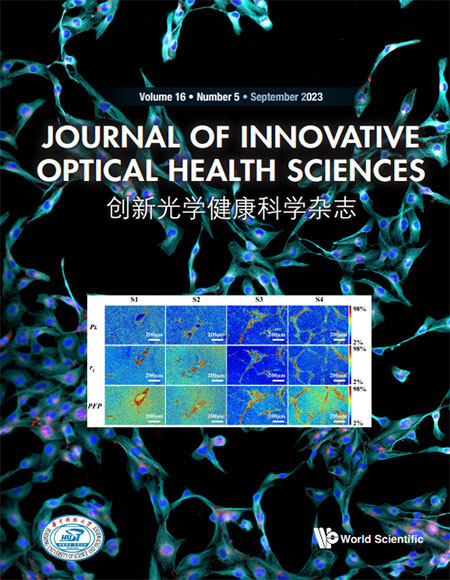High-throughput sorting of two-color fluorescent-labeled zebrafish embryos
Abstract
The zebrafish embryos were widely employed in genetics, development and drug discovery studies as miniatured animal models. Sorting of two-color fluorescent embryos is often required in large-scale experiments but it is challenging to manually sort with high efficiency. Here, we reported a high-throughput sorting system for two-color fluorescent zebrafish embryos. The embryos can be automatically loaded from a sample pool and sorted based on the average fluorescent intensity. The two-color fluorescent signals were split into two lines and detected by an area array camera. The system achieves the sorting of 100 embryos in less than 10min with an accuracy of greater than 95%.
References
- 1. , “Zebrafish as a model vertebrate for investigating chemical toxicity,” Toxicol. Sci. 86(1), 6–19 (2005). Crossref, Web of Science, Google Scholar
- 2. , “Vascular morphogenesis in the zebrafish embryo,” Dev. Biol. 341(1), 56–65 (2010). Crossref, Web of Science, Google Scholar
- 3. , “Zebrafish as a cancer model system,” Cancer Cell 1(3), 229–231 (2002). Crossref, Web of Science, Google Scholar
- 4. , “In vivo drug discovery in the zebrafish,” Nat. Rev. Drug Discov. 4(1), 35–44 (2005). Crossref, Web of Science, Google Scholar
- 5. , “Toxicity assessment and long-term three-photon fluorescence imaging of bright aggregation-induced emission nanodots in zebrafish,” Nano Res. 9(7), 1921–1933 (2016). Crossref, Web of Science, Google Scholar
- 6. , “Immunology and zebrafish: Spawning new models of human disease,” Dev. Comp. Immunol. 32(7), 745–757 (2008). Crossref, Web of Science, Google Scholar
- 7. , “Fully automated cellular-resolution vertebrate sorting platform with parallel animal processing,” Lab Chip 12(4), 711–716 (2012). Crossref, Web of Science, Google Scholar
- 8. , “Image-based fluidic sorting system for automated zebrafish egg sorting into multiwell plates,” J. Lab. Autom. 16(2), 105–111 (2011). Crossref, Google Scholar
- 9. , “Fully automated pipetting sorting system for different morphological phenotypes of zebrafish embryos,” SLAS Technol., Transl. Life Sci. Innov. 23(2), 128–133 (2017). Web of Science, Google Scholar
- 10. , “Automated image-based phenotypic analysis in zebrafish embryos,” Dev. Dyn. 238(3), 656–663 (2009). Crossref, Web of Science, Google Scholar
- 11. , “Three-dimensional reconstruction and measurements of zebrafish larvae from high-throughput axial-view in vivo imaging,” Biomed. Opt. Express 8(5), 2611–2634 (2017). Crossref, Web of Science, Google Scholar
- 12. , “Confocal imaging guided photochemical thrombosis toward the development of a novel zebrafish model of stroke,” 2016 Asia Communications and Photonics Conf., pp. 1–3, IEEE (2016). Crossref, Google Scholar
- 13. , “Label-free photoacoustic microscopy: A potential tool for the live imaging of blood disorders in zebrafish,” Biomed. Opt. Express 12(6), 3643–3649 (2021). Crossref, Web of Science, Google Scholar
- 14. , “A modular, low-cost robot for zebrafish handling,” 2012 Annual Int. Conf. IEEE Engineering in Medicine and Biology Society, pp. 980–983, IEEE (2012). Crossref, Google Scholar
- 15. , “SPIM-fluid: Open source light-sheet-based platform for high-throughput imaging,” Biomed. Opt. Express 6(11), 4447–4456 (2015). Crossref, Web of Science, Google Scholar
- 16. , “Reconstruction of zebrafish early embryonic development by scanned light sheet microscopy,” Science 322(5904), 1065–1069 (2008). Crossref, Web of Science, Google Scholar
- 17. , “Deep and fast live imaging with two-photon scanned light-sheet microscopy,” Nat. Methods 8(9), 757–760 (2011). Crossref, Web of Science, Google Scholar
- 18. , “Light sheet microscopy for real-time developmental biology,” Curr. Opin. Genet. Dev. 21(5), 566–572 (2011). Crossref, Web of Science, Google Scholar
- 19. , “High-throughput in vivo vertebrate screening,” Nat. Methods 7(8), 634–636 (2010). Crossref, Web of Science, Google Scholar
- 20. , “Wide field light-sheet microscopy with lens-axicon controlled two-photon Bessel beam illumination,” Nat. Commun. 12(1), 2979 (2021). Crossref, Web of Science, Google Scholar


